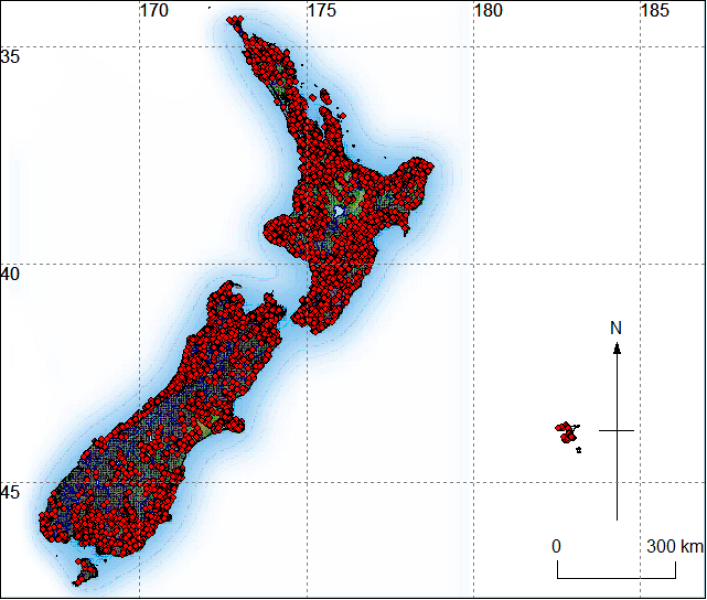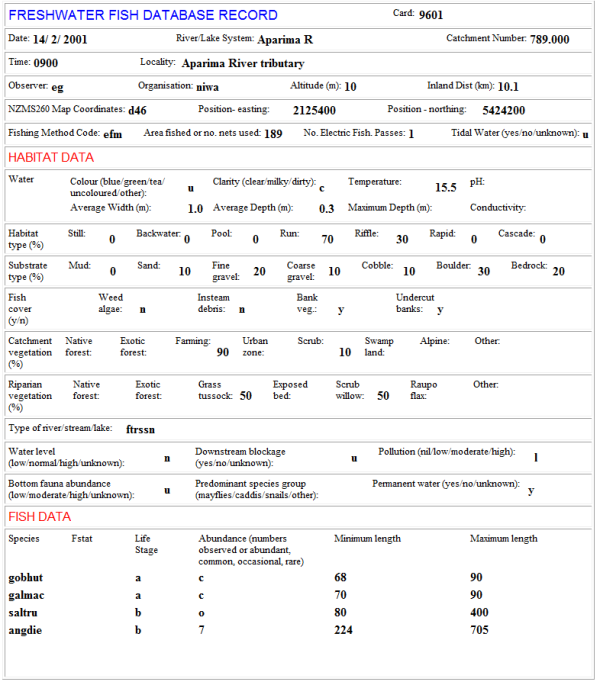There are a number of nationally available resources for the New Zealand public, institutions and companies who need access to well-maintained long-term data repositories. Some of these resources are listed below.
The New Zealand Freshwater Fisheries Database (NZFFD)
The New Zealand Freshwater Fish Database (NZFFD) was established in 1977 and is currently maintained by NIWA. The database records the occurrence of fish in fresh waters of New Zealand, including the major offshore islands. Data stored includes the site location, the species present, their abundance and size as well as information on the fishing method used and a physical description of the site.
Data, which are recorded on pre-printed forms, are contributed voluntarily by individuals and organisations such as NIWA, Fish and Game Councils, the Department of Conservation, regional councils, environment consultancies and universities. Access to the database is free and only requires registration. Users are encouraged to contribute data in return.
Freshwater Fish Atlas
More information about New Zealand's freshwater fish can be found in NIWA's Freshwater Fish Atlas.
Freshwater Biodata Information System (FBIS)
This tool contains fish, algae, aquatic plant and invertebrate data and metadata gathered from New Zealand's freshwater streams, rivers and lakes. The datasets include fish (data collected since 1920), invertebrates (since 1967), submerged macrophytes (since 1981 – see below), and bryophytes, algae, and diatoms (since 1980). Users will have the option of linking biodata with associated environmental data as tables or map layers, and also have web access to enhanced GIS mapping functionality.
National River Water Quality Network (NRWQN)
The NRWQN is operated by NIWA and funded mainly by the Ministry of Science and Innovation (MSI). Monitoring commenced in January 1989. The NRWQN provides reliable scientific information on many important physical, chemical, and biological characteristics of a selection of the nation's river waters. The network consists of 77 sites on 35 rivers that are fairly evenly distributed over the two main islands of New Zealand. The sites and variables measured were carefully selected after reviews of networks in other countries and consideration of their relevance to New Zealand. Data collected by the network has been used by the Ministry in two national State of the Environment (SoE) reports for New Zealand (in 1997 and 2007) and several regional councils have also incorporated NRWQN data into their regional SoE reporting.
NRWQN data is available free to registered subscribers online via the Water Quality Information System (WQIS).
Water Quality Information System (WQIS)
This contains data and metadata on a range of common water quality indicators (e.g., nutrient concentrations, water clarity) gathered from New Zealand's freshwater streams, rivers and lakes. At the core of WQIS is water quality data from the National River Water Quality Network (see above), which has monitored a range of water quality parameters at 77 river sites throughout New Zealand since 1989. All data is freely available.
Environmental Data Explorer New Zealand (EDENZ)
This web site provides access to near real-time and archive data from NIWA's extensive automated environmental monitoring networks for air quality, river flow, sea level and climate.


